|
Get It Here!
Information
Try Averish, one of the most unique Flight Games, if you are a current customer.
|
|
Nitro: Troubleshooting
| The complete troubleshooting guide for remote control nitro vehicles. |
Download |
|
|
| Loosening the Engine |
Explanation – A new engine will typically have a tight fit between the piston and the tapered piston sleeve. This precision fit between the sleeve and the piston is necessary to create the compression required for maximum engine output. A new RC, though, can sometimes be fitted too tightly and requires a bit of loosening.
Solution – Simply follow two simple steps to get going.
- 1. Make sure the engine is not flooded. A flooded engine has some of the characteristics of a stuck engine. For more information on clearing a flooded engine, refer to Clearing a Flooded Engine.
- 2. Locate the flywheel on your RC. It is usually visible from underneath the vehicle frame. Simply wedge a screwdriver into a groove on the flywheel and, using the frame as a leverage point, rotate the flywheel a couple times.
   |
| [Back To Top] |
| Clearing a Flooded Engine |
Explanation – A nitro engine relies on a precise fuel/air mixture for maximum engine output. Air is compressed as it enters the cylinder, which allows for the combustion of the nitro fuel. However, as too much gas enters into the combustion chamber, the mixture can no longer be compressed and this causes the engine to lock up which results in the jamming of the pull start.
Solution –Simply follow these three easy steps to clear your flooded engine:
- 1. Disconnect the glow plug wire from the glow plug if present. Proceed to remove the glow plug from the engine using a two-way 5/16" nut driver.

- 2. Turn the nitro vehicle upside down and quickly pull the pull start a few times. This should turn the engine over at a rapid rate, causing any excess fuel from the combustion chamber and crankcase to be drained. If, after several pulls from the starter, there is still fuel coming out of the engine, continue this process until all the fuel has been drained from the crankcase.

- 3. Be careful to wipe away any raw fuel from the cooling head with a clean rag and reinstall the glow plug. When installing the glow plug, make sure to install the copper glow plug gasket correctly before installing the glow plug.
 
|
| [Back To Top] |
| Charging a Glow Plug Igniter |
 Explanation – The glow plug igniter must be fully charged for an optimal start. If the glow plug igniter is not fully charged, it may lack the power to adequately light the glow plug. This may result in unburned fuel in the cylinder which, in turn, will prevent the engine from starting. Explanation – The glow plug igniter must be fully charged for an optimal start. If the glow plug igniter is not fully charged, it may lack the power to adequately light the glow plug. This may result in unburned fuel in the cylinder which, in turn, will prevent the engine from starting.
Solution – Charge your glow plug igniter by plugging it into its AC adapter or by inserting a fresh battery, depending on the model. Attach the glow plug igniter to the charger, and plug the charger into the outlet. Charge the glow plug igniter for at least 4-5 hours.
|
| [Back To Top] |
| Replacing a Glow Plug |
|
Explanation – Most starting problems center on the glow plug, which is responsible for igniting the fuel mixture. If the glow plug is weak or fouled, it will be unable to ignite the fuel mixture in the compression cylinder. This may result in fuel accumulating in the compression chamber thus preventing the nitro engine from starting.
Solution – The glow plug in your engine must be replaced periodically to maintain peak performance and allow for easy starting. Most starting and performance issues can be traced back to the glow plug. The easiest way to check for a faulty glow plug is to simply install a new one and see if the problem goes away. However, to test the glow plug, remove the glow plug from the cylinder head with a 5/16" nut driver.
Important: Be sure to wipe any excess dirt from the cylinder head beforehand, as dirt can get into the engine. Also, be sure not to lose the copper gasket that seals in the glow plug.
Connect the glow plug to the glow igniter. All of the coils of the glow plug should glow bright white. If the first few coils will not glow, and the rest are bright orange, then you either have a bad glow plug or low igniter power. Recharge the glow plug igniter and try again. If this doesn’t work, you have a faulty glow plug and it must be replaced. |
| [Back To Top] |
| Unblocking the Flow of Fuel |
Explanation – Nitro engines use a glow plug to ignite the fuel mixture in the compression chamber. This reaction is what propels your nitro vehicle forward. However, any obstruction preventing the fuel from reaching the engine will prevent your vehicle from operating correctly.
Solution – Please check that all the fuel lines are clear of any sort of obstructions. Even a tiny pinhole in a fuel line can cause poor fuel circulation and cause noticeable performance issues. If you doubt the integrity of any of the fuel lines, replace them.
.
 |
| [Back To Top] |
| Priming the Engine |
|
Explanation – As the pull start is yanked, the engine will turn over causing fuel to be drawn into the carburetor. Once inside, the carburetor will create the proper air/fuel mixture, where it will be compressed and ignited by the glow plug.
Solution – If fuel is not entering into the carburetor, you can prime the engine by placing your finger over the exhaust while pulling the pull start. Make sure to watch the fuel level and be sure to stop covering the exhaust once you notice fuel entering the carburetor.
Please note: Priming the engine for too long will cause the engine to flood and stall. If this happens, see Clearing a Flooded Engine
 |
| [Back To Top] |
| Readjusting the Carburetor |
|
Explanation – An engine's performance is dependent upon the fuel mixture and is regulated by the carburetor, which, in turn, is regulated by a high speed, low speed, and idle speed setting. Once the proper mixture is achieved, it will be sent to the engine, compressed, and ignited by the glow plug.
Solution – Adjustment of the high speed, low speed, and idle speed settings will tune your carburetor for peak performance. The carburetor can be adjusted to increase (richen) or decrease (lean) the amount of fuel in the mixture which has a direct impact on engine performance.
Important Note: Make sure to completely break-in your nitro engine prior to tuning the engine for maximum performance. See Breaking in Your New Nitro Vehicle.
Important Note: Turn the mixture needles clockwise to create a “lean” mixture and counterclockwise to create a “rich” mixture. A lean fuel mixture will increase engine power, but be wary.
Caution: Never run an engine too lean, because it will cut out or begin to stall. This could cause severe engine damage.
In order to tune your RC for performance, start with a rich fuel mixture and slowly move towards a lean mixture until the ideal mixture ratio is found.
Caution: Never EVER tune from a lean to a rich mixture. There should always be a light stream of smoke coming from the exhaust.
You can tell an engine is running rich by observing any of the following:
 Leaning the high speed fuel mixture increases performance Leaning the high speed fuel mixture increases performance
 Sluggish acceleration Sluggish acceleration
 Unburned fuel spraying from the exhaust tip Unburned fuel spraying from the exhaust tip
Step 1. High Speed Fuel Mixture Adjustment
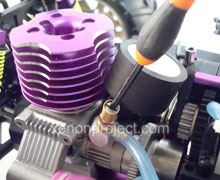 This is primary fuel mixture adjustment. It is located next to the air filter, where the fuel line connects to the engine. This is primary fuel mixture adjustment. It is located next to the air filter, where the fuel line connects to the engine.
After the engine is warmed up, gradually lean the high speed mixture by turning it in 1/16 increments clockwise until an ideal mixture is reached. Make several passes with the RC after each adjustment and note any changes in performance.
- If you "lean" your mixture too much, one or more of these things may occur:
 Fluctuating idle speed Fluctuating idle speed
 Temperature measurement above 270F at the glow plug Temperature measurement above 270F at the glow plug
 Little or no smoke from the exhaust Little or no smoke from the exhaust
 Noise or clattering sound during deceleration Noise or clattering sound during deceleration
 Sudden cutting of power during acceleration Sudden cutting of power during acceleration
 Smoke or steam form the engine (not exhaust) Smoke or steam form the engine (not exhaust)
 Hesitation or stalling during acceleration Hesitation or stalling during acceleration
If you are experiencing one or more of these symptoms listed above, slowly richen the mixture by giving the high speed adjustment 1/16th turns counterclockwise until the symptoms disappear.
Step 2. Low-Speed Fuel Mixture Adjustment
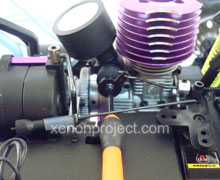 The low speed mixture adjustment is performed only after the high speed needle has been correctly adjusted. The easiest way to adjust the low speed mixture is by doing the "pinch" test. The valve is located where the throttle arm pivots. The low speed mixture adjustment is performed only after the high speed needle has been correctly adjusted. The easiest way to adjust the low speed mixture is by doing the "pinch" test. The valve is located where the throttle arm pivots.
“Pinch” Test
 Having set the high speed needle correctly, take the RC vehicle and pinch the fuel line going into the carburetor. The engine should run for about 2-3 seconds, speed up, and die. Having set the high speed needle correctly, take the RC vehicle and pinch the fuel line going into the carburetor. The engine should run for about 2-3 seconds, speed up, and die.
 If the engine runs longer than 3 seconds, then give the low speed needle a 1/16 turn clockwise. Run the vehicle again and retest. Repeat as necessary. If the engine runs longer than 3 seconds, then give the low speed needle a 1/16 turn clockwise. Run the vehicle again and retest. Repeat as necessary.
 If the test results in the engine dying immediately, without speeding up, richen the low speed needle by giving it 1/8 turn counterclockwise. Run the vehicle again and retest. Repeat as necessary. If the test results in the engine dying immediately, without speeding up, richen the low speed needle by giving it 1/8 turn counterclockwise. Run the vehicle again and retest. Repeat as necessary.
Once the low speed needle is correctly adjusted, the engine throttle should respond very quickly. It is now time to adjust the idle speed.
Step 3. Idle Speed Adjustment
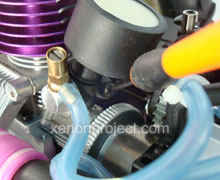 This spring tensioned screw is located beneath the oil filter, facing towards the front of the vehicle. This spring tensioned screw is located beneath the oil filter, facing towards the front of the vehicle.
In order for an engine to run, it must have enough internal inertia built up in the engine to catalyze the entire ignition cycle. Generally speaking, you want to adjust the idle speed to the slowest idle possible, just before it starts to stall. The key is to set the idle speed as low as possible while still maintaining reliable running characteristics. In order to do this, turn the idle screw counterclockwise to reduce the idle speed. If your engine stalls or cuts out, turn it clockwise to increase it. Remember, the goal is to reach the point that is just before the point where the engine stalls and cuts out.
|
| [Back To Top] |
| Refilling the Fuel Tank |
|
Explanation – Nitro fuel refers to the type of fuel used in glow engines. Commonly found in nitro RC vehicles, this fuel is what powers the engine.
Solution – Simply refuel your nitro vehicle. Lift the lid on your vehicle’s fuel tank and insert the fill tube. Slowly squeeze and fill the tank until full. Be careful not to overfill the tank and make sure to wipe off any excess fuel on your tank after filling.

|
| [Back To Top] |
| Replacing Contaminated Fuel |
|
Explanation – Nitro fuel is largely composed of methanol, a form of alcohol. Methanol is a hygroscopic substance, meaning that it absorbs moisture from its surroundings. This can cause your fuel to become contaminated with water, and will translate into poor engine performance. Moreover, the UV rays in sunlight will eventually break down the nitro methane in your fuel if it is stored in sunlight for extended periods of time. Indications that your fuel is contaminated include: the inability to start the engine at previously run valve setting, poor idling capabilities, and varying RPMs while idling.
Solution – Simply remove all the present fuel, and refill with new, uncontaminated nitro fuel.
- Step 1: First remove any excess fuel remaining in the fuel tank.
Remove any leftover fuel by squeezing your empty fuel bottle and inserting the nozzle into the fuel tank. Once in, release the bottle and this should remove any excess fuel. Repeat this process until all fuel has been removed from the tank.
- Step 2: Clear any fuel remaining in the fuel line and carburetor.
You can skip this step if you ran your engine until the fuel tank was dry or if the engine was starved out. Otherwise, insert the glow plug starter and fire up the engine. Once on, let the engine idle (it will run for a few seconds, idle up then stall) until any remaining fuel in the carburetor and fuel line has burned off.
|
| [Back To Top] |
| Clearing a Blocked Exhaust |
Explanation – The engine cylinder moves up and down, as it takes in fresh air and releases exhaust from the burned fuel. If the tailpipe is blocked, exhaust will not be able to leave the cylinder which, in turn, will inhibit fresh air from entering into the engine cylinder. This will prevent engine combustion, and stop your engine from functioning properly.
Solution – Check the exhaust pipe, and remove anything that may be obstructing the airflow within the exhaust, such as dirt and debris. |
| [Back To Top] |
| Cleaning the Air Filter |
Explanation – Regular use of your nitro RC, especially while off-roading, will take its toll on your nitro engine’s air filter. The filter’s purpose is to prevent any dirt and debris that could potentially deteriorate the integrity of your engine from entering the chamber. It is recommended that the filter be cleaned once for every hour of runtime. Even if the filter appears clean, clean it anyway, as there may be tiny amounts of dust and debris in the filter.
Solution –
 |
To clean the air filer you will need:
 Soap and water Soap and water
 Paper towels Paper towels
 Filter oil Filter oil
 Towel (optional) Towel (optional) |
- Step 1. Remove the air filter.
Remove the air filter from the engine carburetor by slowly and carefully pulling it off. Be very careful to not damage the carburetor tubing.

- Step 2. Take apart the filter.
Having removed the filter from the carburetor inlet, take apart the filter pieces and pull out the foam insert.

- Step 3. Washing the filter.
Using your hands, carefully scrub and rinse off every piece of the filter assembly. Thoroughly wash all filter pieces with soapy water and rinse each part under running water.
 
- Step 4. Rinse and dry each part of the filter.
Rinse off the air filter, and carefully dry each individual part. You can use a bottle of compressed air to help speed along this process.

- Step 5. Oil the insert and reassemble the air filter.
Saturate the foam element by spraying the foam with filter oil. Apply about 30 drops of oil evenly to the top, bottom and sides of the filter element. Squeeze the filter in order to spread the oil around the foam. The filter should have oil evenly spread out throughout the foam. Coat the foam with oil, then reassemble the air filter.
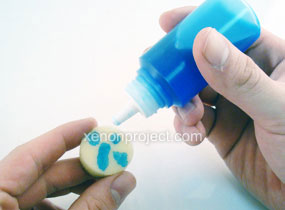 
- Step 6. Reassemble the air filter and install onto the engine.
Reassemble the air filter by placing the foam back into the filter casing and reattaching the casing onto the engine. If you wish, you can use a zip-tie to secure the filter to the engine. This will improve airflow, as it will create an airtight seal around the filter.

|
| [Back To Top] |
| Replacing the Batteries |
|
Explanation - For the transmitter and receiver to function properly, they must receive adequate power.
Solution - Make sure the batteries in both the transmitter and receiver are brand new.
Warning: Weak or dead batteries will result in poor radio transmission and possible vehicle damage due to loss of control.
When inserting batteries, be sure that they are inserted with the correct orientation. With the small directional markings, it can be easy to improperly install the batteries.
 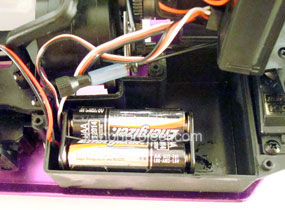 |
| [Back To Top] |
| Verifying the System Can Send / Receive Signals |
|
Explanation - When an input is made by moving the control stick or pulling the trigger, a radio signal is sent out via the transmitter antenna and picked up by the receiver, which is located within the model.
Solution – First, verify the antenna on the receiver is in proper, working condition. Make sure the antenna is neither damaged nor torn.
Make sure the antenna on the receiver has not been damaged or torn, and the antenna on the transmitter is properly screwed in and fully extended.
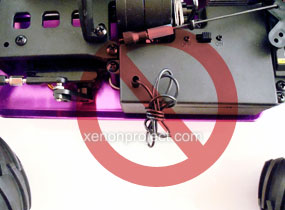 
Note: A wired antenna will extend from within the receiver to outside the model. Never cut or loop this wire to reduce its length. Doing so will drastically reduce the model’s ability to receive a signal, and can result in your RC losing control.
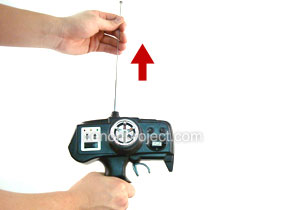
|
| [Back To Top] |
| Check Crystals |
Explanation - Both the receiver and transmitter need their own crystals, on identical frequencies, to operate correctly.
Solution – Please locate the crystals on both the transmitter and receiver. Verify that the frequencies match.
 |
| [Back To Top] |
| Check Servo Connections |
|
Explanation - Once a radio signal is received via the receiver antenna, it is translated into physical movements by the servo.
Solution – Make sure all of the servos are firmly connected to the receiver.
 
The receiver is connected to the servos by small cables, with each servo connected to a separate port on the receiver.
Take the transmitter in your hand, and move the sticks around to verify the operation of every servo.
Step 1. Neutral Position
Begin with the transmitter in the neutral position. Do not move any of the control sticks. Verify that there is no movement from any of the servos during this process. If you notice movement, you may be experiencing interference from another source.

Step 2. Verifying Movement
Now, take your transmitter and move the control sticks, wheel, trigger, etc. in its full range of motion. Verify that these commands correlate to the same movements on the servos. Isolate the controls that direct each servo and verify that each individual servo is operating properly.

Step 3. Trim Adjustments
Trim adjustments allow you to fine tune your servo positions. Make sure to verify your trim adjustments are working properly as well. Not all RC’s come with these trim adjustments, so if it is not included in your transmitter, no need to worry.

Note – The red dots in the image above refer to the trim adjustments
If any of these three examples fail to work on your RC, you may have a busted servo. Simply visit your local hobby shop and find an appropriate replacement.
|
| [Back To Top] |
|
We hope you found this information useful and enjoyed our easy to use tutorial guide. For more tutorials, how-to guides, FAQs, and much more, please visit our Learning Center at XenonProject.com.
Copyright © The Xenon Project, LLC. Any duplication, copying, or use without prior written consent is illegal.
|
|
|
Log In
Note: you do not need an account to place an order!



|
|